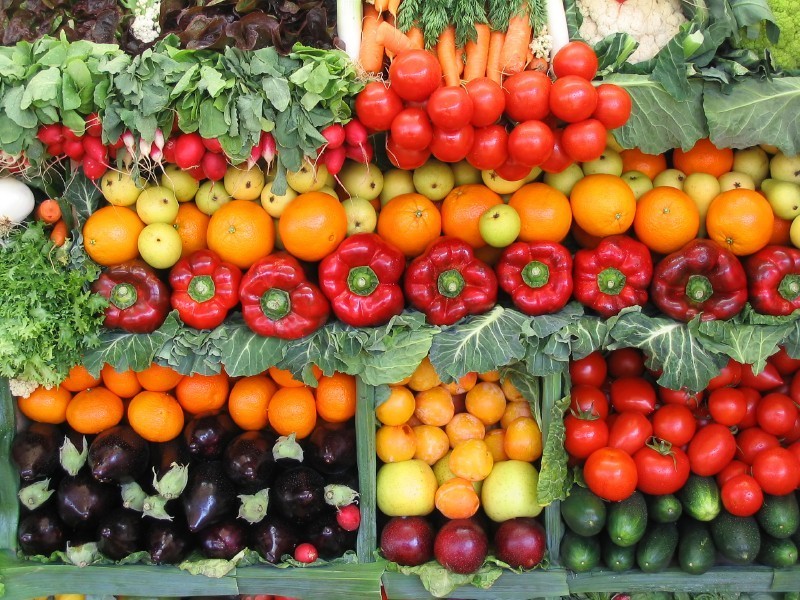March is National Nutrition month, a good time to take a look at popular healthy eating patterns and try to identify which one is right for healthy living. Evidence from AICR shows that diet plays an important role in risk for many cancers, and national and international health organizations agree that what you eat is crucial for overall health and reduced risk of cancer.
I would like to compare two different visual patterns of healthy eating — USDA’s Choose My Plate and AICR’s New American Plate(NAP). Choose my plate promotes specific food group requirements and includes animal foods (although a completely vegetarian diet is an option). The NAP focuses on a mostly plant-based eating pattern with built in flexibility.
Dietary Guidelines for Americans and MyPlate
Since 1980, every 5 years, the US Department of Health and Human Services (HHS) and the US Department of Agriculture (USDA), convene a Dietary Guidelines Advisory Committee to review the body of nutrition science. From the Committee’s report, the USDA creates US Dietary Guidelines for the coming 5-year period. The most recent report was published in 2015.
USDA develops – from these Dietary Guidelines – tools to help guide American families, individuals of all ages, and institutions like schools and childcare centers in making healthy dietary choices. The most recent of these is the “Choose My Plate” tool which replaced “Food Guide Pyramid” in 2011.
MyPlate promotes eating a variety of vegetables, fruits, grains (at least half are whole), fat-free or low-fat dairy, and a variety of protein foods and oils. In addition, it recommends that you limit saturated and trans fats, added sugars and sodium in order to lower the risk for chronic diseases and promote a healthy weight.
The New American Plate – Out with the Old, In with the New
The New American Plate (NAP) draws on AICR’s evidence-based recommendations for cancer prevention. NAP helps you manage your weight. Maintaining a healthy weight can help reduce the risk of developing diabetes, cardiovascular disease and many cancers.
The emphasis in the NAP is to follow a mostly plant-based diet with a built-in flexibility. It is very easy to follow. Just make your plate look like this:
How do I use the NAP in my own life?
1) I always keep extra vegetables in my refrigerator. If I need more vegetables to complete my plate, it is easy to add some steamed broccoli, asparagus, kale, spinach, green beans, cabbage, or other greens. Most nights, I serve at least 2 vegetables on the plate (often 3), in addition to whatever else I have on the menu.
2) I always serve a salad with every meal.
I wash and tear the lettuce on the weekend and store it wrapped in a paper towel and plastic in the fridge. When you are ready to make dinner, your greens are all set to go. Just add a few cherry tomatoes, maybe some scallions, a few pieces of chopped peppers, and some homemade dressing (3:1 ratio of olive oil and vinegar, a tiny bit of salt and pepper, and on some nights a little mustard or other herbs to give some variety).
3) I like to make casseroles and hearty soups that include vegetables. For example, I make chicken pot pie with a whole pound of mixed vegetables mixed in, white spinach lasagna, and vegetarian split pea soup for nights when I know I will not have time to cook, but still want a healthy dinner.
4) I experiment with different whole grains as part of most dinners and almost never serve white rice. Brown rice, quinoa, bulgur wheat, whole wheat couscous, and Japanese buckwheat noodles are staples in my pantry and I use them to complement whatever else is on the plate. I often make a little extra of whatever grain I am serving and then use it in a salad the next day for lunch.
I keep a wide variety of herbs and spices in my pantry so it is easy to make dishes from around the world. One night I will make a Japanese-style meal, other nights I will cook Indian curry, Mexican enchiladas, or an Italian-style fish.
Why is this important?
Research shows that eating a mostly plant-based diet, with some additional lifestyle changes, and maintaining a healthy weight can reduce the risk of developing cancer.
And, isn’t that a good thing?







